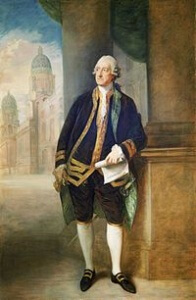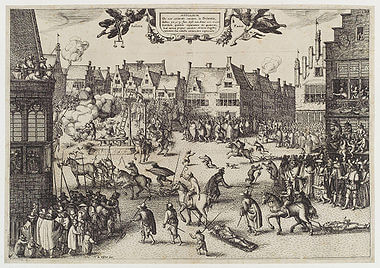Today is National Sandwich Day. On November 3, 1762, John Montagu, 4th Earl of Sandwich, invented the—you guessed it!—sandwich. But why, where, how and who?
Why?
He was hungry. That’s just about the only subject upon which everyone agrees.
Where?
He was either working long hours at his desk or playing poker in a gambling hall.
How?
He ordered a servant to fetch him salted meat between two slices of bread so he could continue working (or gambling) without smearing grease on his papers (or cards).
A version of events that spread the gambling rumor was reported by P.J. Grosley in his travelogue Tour to London:
A minister of state passed four and twenty hours at a public gaming-table, so absorpt in play that, during the whole time, he had no subsistence but a bit of beef, between two slices of toasted bread, which he eat without ever quitting the game. This new dish grew highly in vogue, during my residence in London: it was called by the name of the minister who invented it.
N.A.M. Rodger dismissed this account in his biography The Insatiable Earl:
The alternative explanation is that he invented it to sustain himself at his desk, which seems plausible since we have ample evidence of the long hours he worked from an early start, in an age when dinner was the only substantial meal of the day, and the fashionable hour to dine was four o’clock.
Who?
Thankfully, the 1st Earl changed his mind about taking the title of Earl of Portsmouth and decided to honor the town of Sandwich instead, possibly because the fleet he commanded was tied there in 1660. Ordering a Portsmouth would be tricky to pronounce correctly, depending on which side of the Pond you’re on.
His great-great-great grandson John, the 4th Earl of Sandwich, probably got the idea for his creation on a trip to the Mediterranean, where Turkish and Greek platters of dips, meats and cheese were served with layers of bread. The first known use of the word “sandwich” in its current context is attributed to historian Edward Gibbon, author of The History of the Decline and Fall of the Roman Empire, who wrote in a journal entry dated November 24, 1762:
That respectable body, of which I have the honour of being a member, affords every evening a sight truly English. Twenty or thirty, perhaps, of the first men in the kingdom, in point of fashion and fortune, supping at little tables covered with a napkin, in the middle of a coffee-room, upon a bit of cold meat, or a sandwich, and drinking a glass of punch.
By 1773, the word “sandwich” had been used in a cookbook for the first time and would forever be associated with Montagu.
Of course, he didn’t invent the sandwich. Rabbi Hillel the Elder is said to have begun, in the 1st Century B.C., the Passover tradition of placing lamb, nuts and herbs between two pieces of unleavened bread in the 1st Century BC. In the Middle Ages, thick slices of stale bread were used as plates for cooked meats and vegetables. The Dutch have a long tradition of serving bread & butter with meat, fish or other fillings and toppings.
But the name stuck so that’s what we call it and it is, for most of us, the only reason we know anything about John Montagu. Though he must have been a big hit with bakers, he was branded as immoral and incompetent by many of his contemporaries. Recently, some historians have suggested that previous accounts have relied too heavily on sources from his political enemies.
Lord Sandwich was also haunted by his troubled personal history. His wife Dorothy became increasingly mentally ill during their marriage. They separated and she went on to live with her elder sister, continuing to deteriorate until she was declared insane and committed.
Montagu took a mistress, singer Martha Ray—reputed to be the inspiration for “My Fair Lady”— and lived with her and their children openly. Divorce was not an option, let alone living in sin. His reputation was irreparably damaged. It ended in tragedy when she was shot to death by a clergyman who was later rumored to be her lover, although there was no evidence of anything more than a crush on his part.
There’s also the fact that he was First Admiral of the Navy during the American Revolutionary War. That didn’t go so well for the British Empire, as you may recall.
Clearly, there is too much meat in this story to fit between two slices of bread, metaphorically speaking. You can learn much more at PBS.org, Encyclopaedia Britannica, Montague Millenium, Open Sandwich and Your Dictionary,
Happy National Sandwich Day!

![]()




